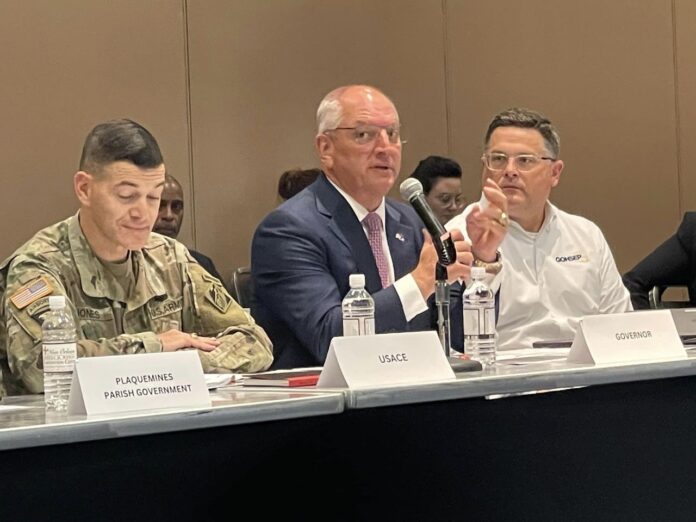BATON ROUGE, La. – Today, Gov. John Bel Edwards held a modified Unified Command Group (UCG) meeting in New Orleans for an update on the saltwater intrusion threat that continues to grow in the Lower Mississippi River region. Gov. Edwards was joined by several parish presidents and officials from the Governor’s Office of Homeland Security and Emergency Preparedness (GOHSEP), the Louisiana Department of Health (LDH) and the US Army Corps of Engineers (USACE).
The current National Weather Service Mississippi River forecast indicates river volume will fall to historic lows over the next several weeks. As a result, salt water from the Gulf of Mexico is intruding upstream. Plaquemines Parish has been affected by this issue since June. Drought conditions have only gotten worse since that time, which means additional communities along the Mississippi River could be impacted.
“Unfortunately, without any relief from the dry weather we are starting to see the saltwater intrusion creep further up the river despite efforts to mitigate the problems by the Army Corps of Engineers. Our team at GOHSEP is working with all of our local, state and federal partners to determine what additional support will be needed and what steps can be taken to protect water systems and water intake points. Most importantly, this is not a time to panic or listen to misinformation. We have been through this situation before in 1988, and we are monitoring this situation very closely and applying the lessons learned. It is extremely important for the public to stay informed and only rely on credible sources for updates during this event.”
Gov. Edwards
USACE constructed an underwater barrier sill in July 2023 to create an artificial basin to help delay the ingress of saltwater. Earlier this week, the upriver intrusion of saltwater from the Gulf overtopped the sill’s existing elevation. Soon, additional work will begin to further delay an increase of the intrusion.
“The Corps of Engineers will pursue every effort within our authority to support the state and local response to the extreme low-water conditions,” said Col. Cullen Jones, USACE New Orleans District commander. “Next week, we will begin augmenting the existing underwater sill to further delay the upriver saltwater progress by an estimated 10 to 15 days. Concurrently, we are establishing the capability for barging freshwater to municipal water treatment facilities to support local production of safe drinking water.”
Saltwater intrusion can threaten the quality of drinking water for parishes that have water intakes along the Mississippi River where intrusion occurs, although no parishes upriver from Plaquemines Parish are likely to see any change in their drinking water until mid- to late October. Water systems that will eventually be affected include St. Bernard, Orleans and Jefferson parishes.
LDH, which regulates all water systems in Louisiana, is working closely with parish officials to monitor changes through water testing. LDH will issue guidance through emergency.la.gov/saltwater with information about what to do once saltwater intrusion occurs, as well as precautions for vulnerable populations. LDH will continue to issue guidance for the public and healthcare providers, as well as work with water systems to monitor for changes in drinking water quality.
The Governor’s Office of Homeland Security and Emergency Preparedness (GOHSEP), the US Army Corps of Engineers and the Louisiana Department of Health are working with local officials and coordinating support for all of the impacted areas as these conditions continue.







